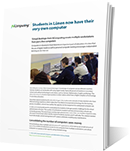DIE ERFOLGSSTORY
Students in Lünen now have their very own computer
Virtual desktops from NComputing create multiple workstations from just a few computers
Computers in classrooms have become an important part of education. It is clear that the use of digital media as well as personal computer training encourages independent learning on the Internet.

According to a survey1, that measured teenagers’ knowledge of computers across different countries, German students are not familiar with using digital media. Nearly 80 percent of students in secondary school work without technology in core classes, such as German, Mathematics, English and Biology. This places Germany in a disadvantaged position to other nations which have a higher adoption of technology in secondary education.
One of the reasons explaining this educational gap is the traditionalist attitude of many teachers who have little technology experience which makes them less likely to incorporate technology into the learning process. In addition, schools have neither the capacity nor the equipment for widespread computer use.
In 2006, an increasing demand for workstations for students of all ages posed a challenge for the school administration of Lünen. The number of workstations needed in primary and secondary schools was constantly growing. The lack of space and the high administrative costs of the new facilities required a new, affordable infrastructure which met the needs of students, teachers and IT staff alike. The solution needed to provide simple, central management of IT systems whilst also enabling easy maintenance.
Consolidating the number of computers saves money
Virtual desktops allow multiple users to access ICT applications, while taking up a small amount of space.This enables simultaneous access to one computer from multiple workstations and allows computers to operate at full capacity using minimal energy.
Distributor Tarox offered the City Council of Lünen NComputing’s low-cost virtual desktop solutions, which are easy to use, reliable and compatible with preinstalled applications. The implementation of NComputing’s vSpace Server was initially discussed in 2007 and the actual deployment took place a year later.. The technology was implemented across many primary and secondary schools, as well as comprehensive and special schools.
The school administration provided each of the computer rooms of Lunen’s primary schools, with up to 12 centrally managed workstations, whilst secondary schools were equipped with up to 30 virtual desktop clients per room. Moreover, the schools computer facilities were used by the local community college for their evening computer courses which further facilitated the access to PC technology for educational purposes.
Over the course of time, thirteen different schools in Lünen have deployed L300 clients, providing a total of 230 desktop workstations for students. The L300 is easy to set up and does not need a complicated server infrastructure. The thin clients receive automatic updates from the vSpace Server. Moreover, the limited use of power, combined with the smaller size of the thin clients allows Lunen to significantly reduce energy consumption.
The L300 thin clients, in combination with only one vSpace Server, enable the connection of 100 workstations. This offers an easy and powerful desktop virtualisation solution at only one third of the cost of standard devices. Furthermore the school administration installed U170 access clients, which connect the shared computers with a USB cable that also supplies the client with power.
The adoption of desktop virtualisation solutions enabled the school administration of Lünen to massively cut costs. Instead of buying new hardware, existing computers could be used more efficiently. The work for installation decreased to just one third and energy consumption dropped from 350 watts to only 5 watts per thin client.
“Due to the higher capacity we are now able to provide every room with computer access depending on the size of the class, so that every student has their own workstation. In the past, two students had to share one computer.” explained André Heine, IT coordinator of the school administration.
“Desktop virtualisation also significantly reduces the heat in computer rooms and teachers and students feel the benefits from this in the summer” he added.
Overall, the virtual desktops and the centralised administration, has enabled better e-learning opportunities for students and teachers without producing extra maintenance costs. The introduction of virtual workstations has enabled faster set up of new desktops for students, while-enabling IT staff to manage every thin client from just a single server.
The teachers also reacted well to this deployment, giving IT staff plenty of positive feedback. “The teachers’ acceptance is very important to us, because a lot depends on their willingness to more actively use computing technology for educational purposes.” added Heine.
“We wanted to find an easy way to achieve that.” The school administration already plans on equipping even more schools with L300 devices to achieve the goal of providing every school with NComputing clients in the near future. The use of a central vSpace Management Center is also under consideration.
1 ICILS 2013 (International Computer and Information Literacy Study) http://www.ifs-dortmund.de/1852.html
Suggested reading




